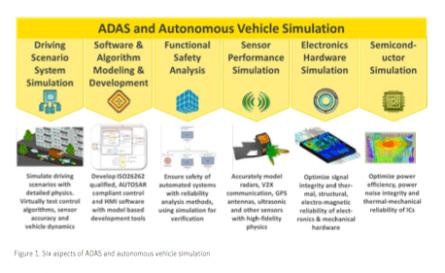When thinking of ADAS from an embedded system perspective, it is tempting to imagine that system can be designed to some agreed margins without needing to worry too much about the details of the car environment and larger environment outside the car. But that’s no longer practical (or acceptable) for ADAS or autonomous systems. The complexity of control challenges and environmental interference in the car and outside the car (see e.g. my earlier blog on 5G) require that modeling for design at the total system level begin well before component implementation (and perhaps even architecture) is locked down.

REGISTER HERE for the Webinar, either 6am PDT and 1pm PDT (both April 20[SUP]th[/SUP])
The way to get there is through comprehensive driving-scenario simulations, conducted with a system-level behavioral model of an autonomous or semi-automated vehicle. This model includes all sensors, antennas, control systems, drive systems and vehicle body, placed in situ in a virtual driving environment of roads, buildings, pedestrians, road-signs, etc. In this simulated environment, thousands of driving scenarios can be evaluated rapidly, to test whether the vehicle’s sensors, control algorithms, and drive systems perform as expected under situations.
REGISTER HERE for the Webinar, either 6am PDT and 1pm PDT (both April 20[SUP]th[/SUP])
Sensors, antennas and electronics are the brains behind today’s intelligent Advanced Driver Assistance Systems (ADAS). Advances in integrated antenna design, image sensing and integrated circuit design are quickly transforming automotive vehicles into autonomous vehicles. These advances are also helping build cheaper, safer and more intelligent ADAS systems. As the design of these ADAS systems becomes more complex, though, design engineers must rigorously simulate multiple components and systems for functionality, reliability and safety.
About the Presenters
Larry Williams
Larry is Director of Product Management at ANSYS’s Electronics Business Unit. He is responsible for the strategic direction of the company’s electrical and electronics products, including the High Frequency Structure Simulator (HFSS) finite element simulator and is an expert with over 20 years experience in the application of electromagnetic field simulation to the design of antennas, microwave components, and high-speed electronics.
Jerome Toublanc
Jerome is a Business Development Manager for ANSYS Semiconductor Business unit. He has over 15 years of experience in SoC Power Integrity and Reliability challenges for large range of technologies, from RTL to GDSII level, and from Chip, Package to System level.
Arvind Shanmugavel
Arvind is senior director of application engineering at ANSYS.







Comments
There are no comments yet.
You must register or log in to view/post comments.